Hall for the Arts: Wayland Hall
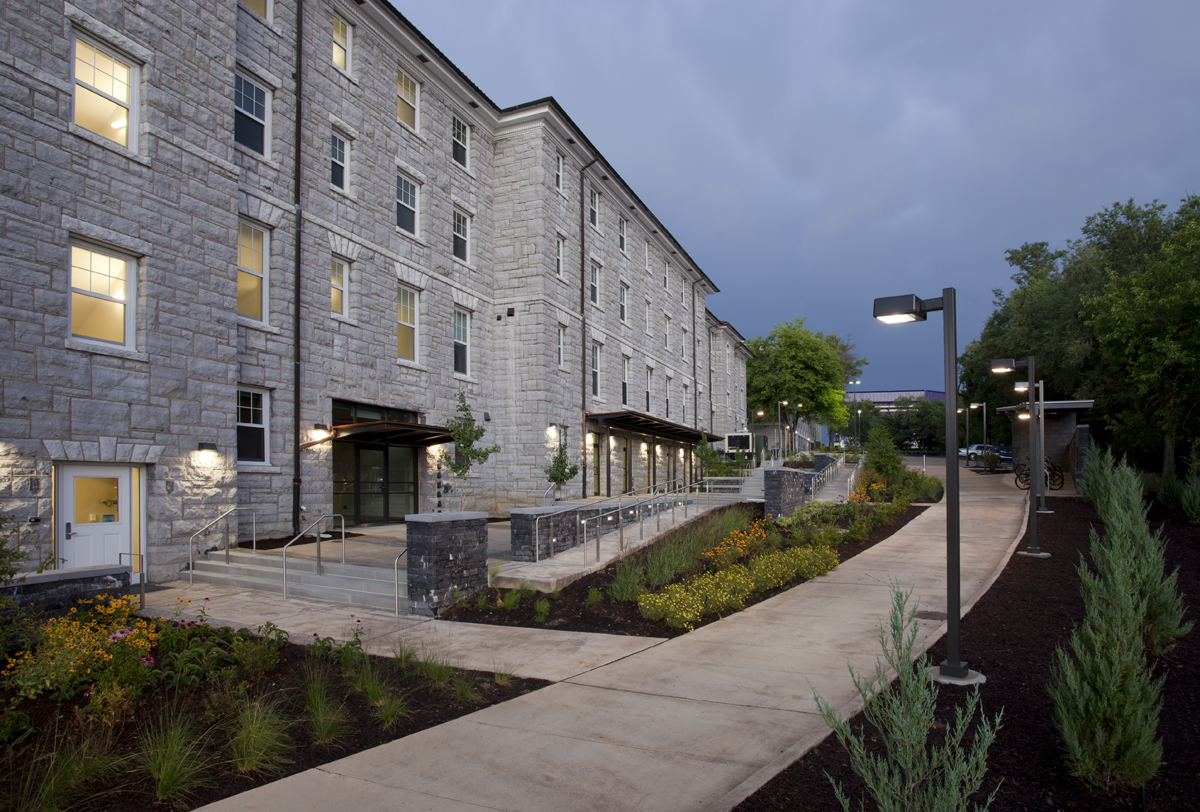
Walking into the lobby of the newly renovated Wayland Hall you immediately feel like you are somewhere important. You know you are at JMU, but this version of residential living elevates the on-campus experience to new levels of sophistication, function and form.
Wayland has been transformed into a hall for the arts, a true living and learning center where students in the newly formed Visual and Performing Arts Community will reside, practice, perform and display their art. Moreover, the incredible attention in the redesign to creating a more sustainable living environment makes it the perfect place to house Madison Eco, the learning community focused on environmental issues.
Interdisciplinary Hall
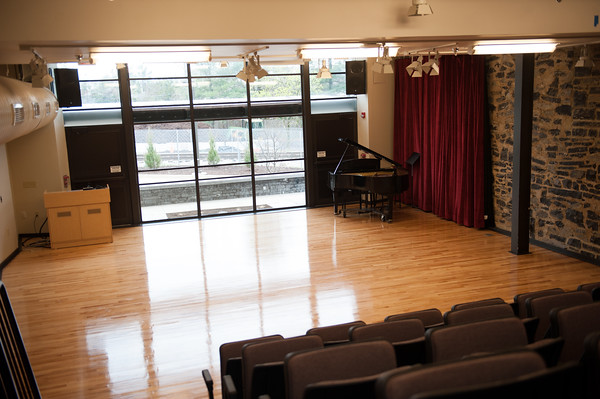 You can almost hear the instruments, see the dancers and feel the passion of the arts students who will be living in Wayland just by touring the building. The ground floor is filled with art-centered spaces including a studio filled with easels, natural light and access to the outdoor terrace. Two sound-insulated practice rooms with excellent acoustics can accommodate a quartet or quintet.
You can almost hear the instruments, see the dancers and feel the passion of the arts students who will be living in Wayland just by touring the building. The ground floor is filled with art-centered spaces including a studio filled with easels, natural light and access to the outdoor terrace. Two sound-insulated practice rooms with excellent acoustics can accommodate a quartet or quintet.
Former College of Visual and Performing Arts Dean George Sparks, who passed away on September 13, 2020, took an active role in creating an arts community at JMU. "This was a chance to build a distinct program around this living space," said Dr. Sparks. When the hall first opened, he taught an interdisciplinary class in the fully mediated, large ground-floor classroom.
The most jaw-dropping space in the building is the performance hall. With seating capacity of 100 and an entire wall of exposed bluestone, the hall can be used for dance, theater or music. It will be used for resident performances throughout the year and Sparks said he could foresee teaching classes in the space as well.
Inside Job
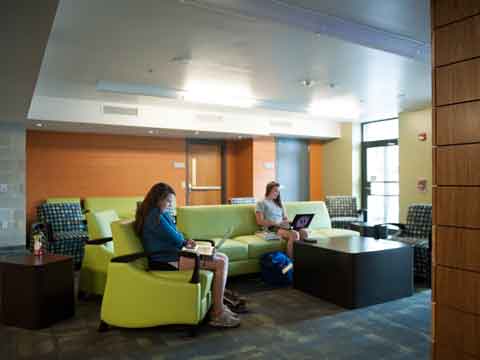
Maggie Evans, director of residence life, said the building was completely gutted during the renovation. "We spent a lot of time in the design phase talking to students," she said. The inside of the building changed dramatically, including bedroom size, bathroom locations, lounge areas and study rooms.
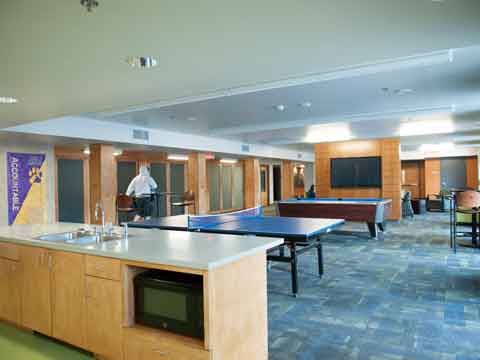
Walking into the first floor you are no longer met with 1950s French-doors and closed-off, dimly lit halls. Instead you walk on bluestone slate floors, past shiny wood columns into a well lit, museum-quality art gallery.
Furniture that moves, huge wipe boards in the study lounges, thermostats in each room and a full kitchen on the ground floor will help students feel at home. "We created spaces that are meaningful and purposeful for the students," said Evans.
An Eco Community
While the building was designed with a focus on the arts, the underlying theme is environmental impact. "The sustainability component is what distinguishes Wayland from past renovations," said Evans.
Michelle Westrick of VMDO Architects cited the 32 600-foot wells dug in back of the building and the 10,000-gallon water tank that will collect rainwater as examples of the many resource-saving additions that were made to the building.
"The geothermal HVAC system will utilize ground source water to make heating and cooling the building more efficient, leaving a smaller carbon footprint," said Evans.
Although many of the sustainable efforts in the renovation are unseen, there was much care put into the interior walls, carpets and living spaces. "All the materials were carefully selected with sustainability goals in mind," said Westrick. This includes the use of the reclaimed room doors from before the demolition that now are imbedded into the corridor walls to add to the design of the halls.
Evans said plans are in place to "tell the story" of the sustainable efforts used in the building phase and the current living space through video and signage throughout the building.
LEEDing the Way
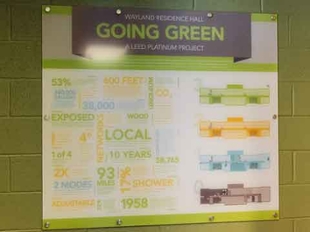 James Madison University's Wayland Hall is the first renovated residence hall in the country to receive the Leadership in Energy and Environmental Design platinum award. The U.S. Green Building Council awarded the renovation of Wayland Hall the platinum certification, the highest LEED certification status, on Jan. 11, 2011.
James Madison University's Wayland Hall is the first renovated residence hall in the country to receive the Leadership in Energy and Environmental Design platinum award. The U.S. Green Building Council awarded the renovation of Wayland Hall the platinum certification, the highest LEED certification status, on Jan. 11, 2011.
"Wayland Hall exemplifies JMU's commitment to being a model steward of the natural world," said Dr. Christie-Joy Brodrick-Hartman, executive director of the JMU Institute for Stewardship of the Natural World. "Staff from many areas across the university contributed to the project, and their achievement reflects that environmental stewardship is becoming a part of our culture."
Wayland Hall is one of just four full-scale LEED platinum residence halls in the country, and the first to achieve platinum status for a renovation under USGBC’s new construction guidelines. LEED-certified buildings are designed to lower operating costs, increase asset value, reduce waste sent to landfills and conserve energy.
According to David Oakland, principal of VMDO Architects, the firm that worked with JMU on the renovation, Wayland Hall's deep energy retrofit is expected to reduce the building’s energy consumption by 39 percent and save 1.3 million gallons of water annually. The building utilizes a ground-source heat pump and well field, a 10,000-gallon water tank to collect rainwater and the showers have a drain-water heat recovery system. VMDO's design increased natural light and sustainable materials were used on the interior walls, carpets and living spaces. The outside of the building has natural landscaping and a parking lot was converted to green space behind the residence hall.
"The sustainability component is what distinguishes Wayland from past renovations," said Maggie Evans, director of the Office of Residence Life. Evans said the rooms have multiple light fixtures and switches and residents can control the temperature in their rooms. "There are also sensors on the window so that if a student decides he or she wants fresh air, when the sensor reads the window as open, it automatically turns off the HVAC so we are not wasting energy," said Evans.
“Wayland Hall is special in that it exposes students to environmental stewardship as part of their daily living," said Oakland. "College is a formative time in students’ lives. We hope the building – in addition to performing with exceptional efficiency – inspires students to pursue conservation throughout adulthood.”

